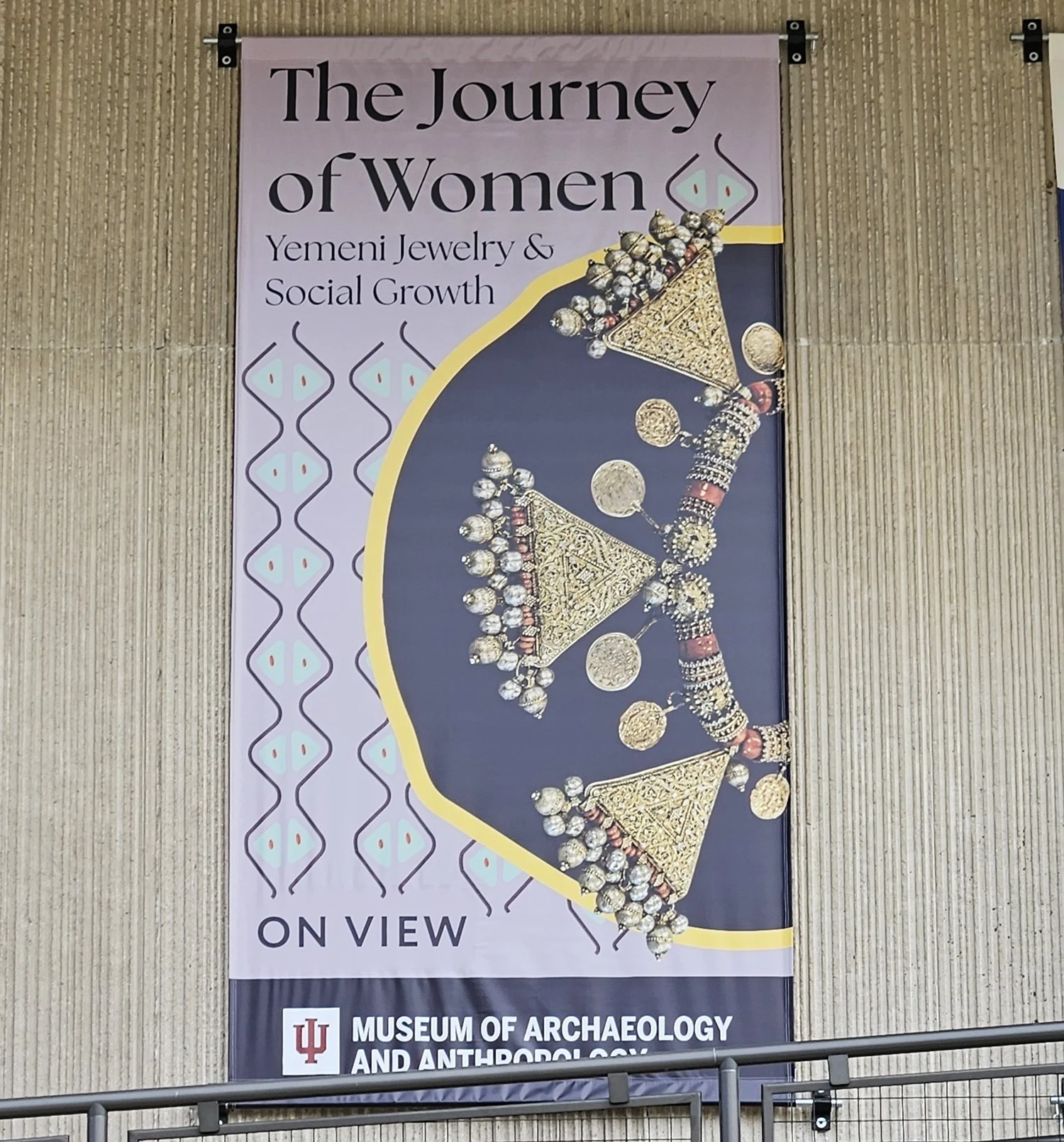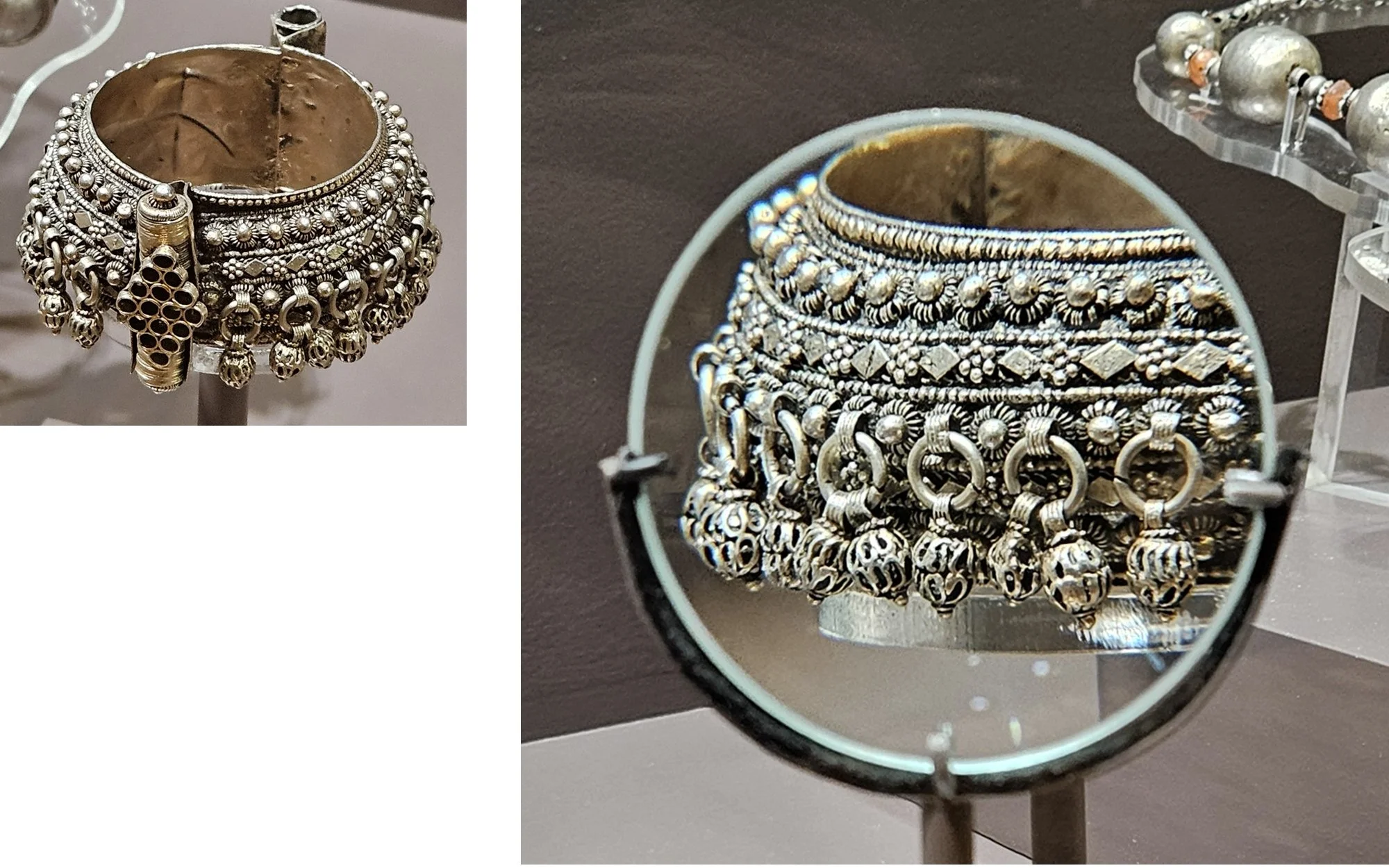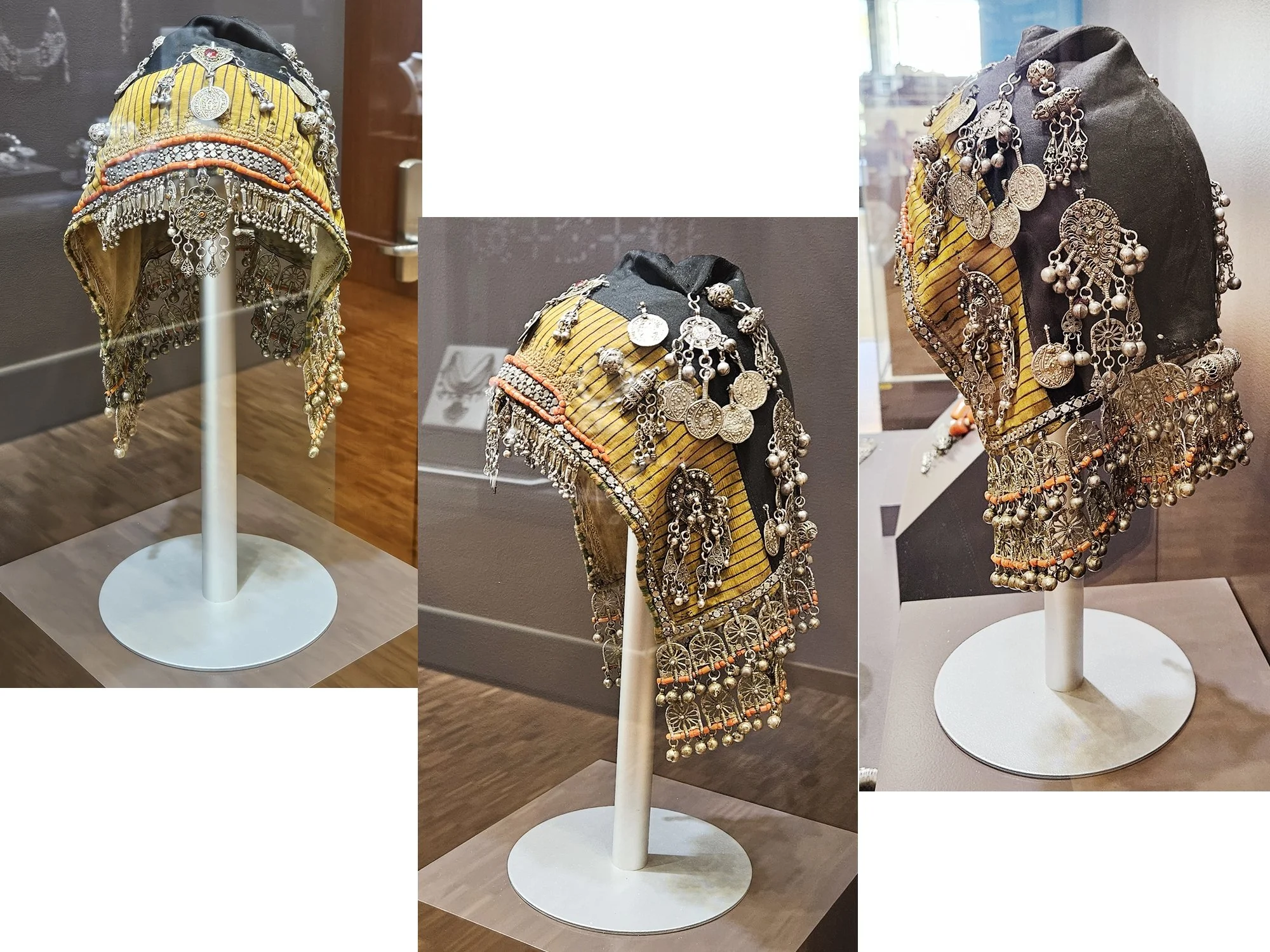Viewing IU’s Exhibit of Yemeni Jewelry from the Ransom Collection - The Journey of Women
Photos, notes, and thoughts on the jewelry pieces and information presented in this exhibition.
Exhibit banner outside the Museum.
On November 1st, I visited the Indiana University Museum of Anthropology and Archaeology’s exhibit “The Journey of Women”, containing Yemeni jewelry and textile adornments in Bloomington, Indiana. If you have not heard of this collection, or the gifting of a portion of this collection to the museum, you may want to begin HERE, with my prior blog entry on what the collection is, what it contains, and it’s history / origins.
ABOUT THE INFORMATION GIVEN HERE
I took photos and recorded some of the information on the pieces included in the exhibit so you can see them and learn something about them. The exhibit was presented in the main hall of the Museum and consisted of seven display cases. My numbering of the cases is based solely on the order presented and is simply my own numbering to keep track of where things are located. There is no official order or numbering system to the exhibit.
Each display case contained between 6 and 15 pieces. Many of the items are shown as undated and the maker unrecorded, although more information was included where known. In a very few instances it also appeared that some of the pieces either had NO information given, conflicting information given, or it was not clear which information went with which piece. I have presented the information according to what makes the most sense to me, but it may be inaccurate in places.
Many of the pieces in this exhibit are also part of Marjorie Ransom’s book Silver Treasures from the Land of Sheba and there is more information about those pieces there. If the information from the book gives more depth, I have included it here.
View of the main hall where the exhibit was located, looking from display case number 6 backward toward case number 1.
CASE NO. 1
The first case contains bridal jewelry, most from Sana’a. Included in this case is a silk dress and leggings, a large silver necklace with coral, a beautiful silver filigree belt with agate insets, a pair of silver bracelets or arm bands, a silver ring, two pair of headpiece adornments, and a silver amulet box pendant.
Case No. 1 - Bridal attire and jewelry from Sana’a.
The information presented with this case notes that the belt is considered the most important and valuable piece of jewelry a woman can own. No matter her age, a women does not give away or sell her belt. A bride may refuse to wear her bridal attire if a belt is not included. The belt shown here is indeed exquisite and was made by Harun Bawsani, 1910s.
INFORMATION FROM THE BOOK: This belt has the whale and flower motif in filigree pieces and is signed by master craftsman Harun Bawsani. The whale and flower motif appears in many pieces of Yemeni jewelry, but the author was unable to find out what it signifies.
Gorgeous silver filigree belt with agate insets. 1910s. Harun Bawsani, Sana’a.
The necklace shown in this case is not specifically known as a bridal necklace. The information presented notes that this type of necklace was an essential piece created for women of the households of important tribal leaders in the Sana’a region and was worn on all occasions, including weddings. This piece was also made by Harun Bawsani, and was created between 1910 and 1920.
INFORMATION FROM THE BOOK: The two-sided hollow filigree triangles on this rare necklace are made of filigree and granulation with arabesque designs. The larger beads are of finely wrapped wire. The necklace, except for the dangles, is gilded. It is unusual to see such fine work in a necklace for women, as this quality of work is usually reserved for men’s daggers.
Silver necklace with coral. 1910-1920. Harun Bawsani, Sana’a.
CASE NO. 2
This display case contains two silver necklaces with crescent pendants made of hyena bone, a silver necklace with a large beautifully worked pendant, a pair of hair ornaments (one turned to the back to show the Maria Theresa coin), seven silver rings - two of which are adorned with coral, a slim silver belt with fish links (coiled) and two bracelets or armbands.
Case No. 2 - Contrasts in value.
These items show the contrast between more expensive and less expensive pieces. The coiled belt is slimmer and lighter than the one in the first case. The bracelets here are noted as made with the intention that they be worn as single pieces, but also states that rich women would wear them in pairs.
The two silver necklaces below with crescent pendants of hyena bone, silver and agates/carnelian/glass insets show the differences in expense clearly. One is quite large and highly decorated and the other is smaller with less ornamentation. Both serve the same purpose, and each is elegant in it’s own right.
FROM THE BOOK: Amulet necklaces made of animal bone promised fertility and protection against the evil eye. This type of necklace was worn on the wedding night.
Silver necklaces with hyena bone crescent pendants. Makers’ names are unrecorded. The larger necklace is estimated to have been made in the 1920s. Hadramaut region.
The large necklace shown below is exceptional. Made of silver with “white quartz and green sapphire” insets. The accompanying information for this necklace tells us that it was made in Wadi Daw’an by a Jewish silversmith, but the name of this silversmith was unrecorded. Only the wealthiest of women could afford such a piece. It is also noted that there is no one today who is sufficiently skilled to replace it. The history and tradition of silversmithing in Yemen is fascinating and is an important part of the story of Yemeni jewelry. You can find out more about it HERE.
INFORMATION FROM THE BOOK: A kisra is a unique amulet with a bat-like shape worn in Hadramaut by married women every day for protection.
A note on comparison between the items shown in the book and items as they are on display today. The photo here shows at least one place where the wirework on the face of this pendant is missing. The photo of this necklace in the book shows most of the wirework in place. Unfortunately there are several pieces displayed in this exhibit that have small beads, ornamentation, bells, etc. that are present in the book photos and now are missing.
Large silver necklace with unique amulet ornamented with precious and semi-precious stones. 1930s. Maker unrecorded. Hadramaut.
CASE NO. 3
The third display case contains three types of jewelry meant to be worn on the head, two large necklaces, an intricately worked bracelet and one very very large amulet pendant with huge bells.
Case No. 3 - Various types of silver jewelry. No stated or obvious connection.
This display contains two of my favorite pieces in this exhibit. First is the VERY large amulet pendant in the center of the case. Made entirely of silver, this piece is larger than any similar amulet I have ever seen before. Compare to the wrist bracelet beside it. My best estimation is that it is from 9 to 12 inches across. And the BELLS are as large as quarters!! The silversmith left a message on the back for the wearer: “This was made by Mahfuz Said al-Amari, for the health of the one who will wear it.”
INFORMATION FROM THE BOOK: The bride must wear an amulet! This extraordinary piece weighs 1,740 grams, or over three pounds. The bride wore it the day before she went to the groom. She danced and held the amulet and the chain in her hand, shaking it in time with her feet as she stamped the floor.
Extremely large silver amulet case with 38 to 40 quarter-sized bells. 1958. Mahfuz Said al-Amari. Shihr, Hadramaut.
The second piece I would like to point out in this display case is the necklace shown below with three round pendants. The information for it notes that this type of distinctive necklace is worn not only by brides but also married women at parties. It’s no wonder then that I find this to be one of the most compelling pieces in the entire exhibit! Silver, red (glass) cabochons, agate beads, Hadrami beads, carnelian. Estimated to be from the 1950s. The maker is unrecorded.
INFORMATION FROM THE BOOK: This necklace reflects the popularity of the color red in Habban jewelry. The Habban costume also features red, along with extensive use of small shells.
Silver necklace with red insets and various types of beads. 1950s. Maker unrecorded. Habban, Shabwa.
Detail on one of the pendants from the silver necklace above, adorned with red insets.
Nestled between the two necklaces with a small magnifying glass next to it is a silver bracelet with very fine detailing. Accompanying information states that this beautiful piece comes from the north of Yemen and was made by silvermsith Sulayman Qara.
Finely detailed silver bracelet from the north. 1910s. Sulayman Qara silversmith. Mahweet.
CASE NO. 4
Case No. 4 contains ornaments for the hair and head. There are a pair of hairpieces, a single hair adornment, a headband-type headpiece and a “bonnet”, or headcovering. There are also two necklaces - one of amber and one of silver, and two silver bracelets included in this display.
Case No. 4 - Miscellaneous pieces, no stated connection.
The information provided on the hairpieces was a bit confusing and I could not tell with certainty which piece the specific information was about. I have shown the two hairpieces in the photo below with my best assumption as to which information goes with which piece.
The first is a pair of silver hairpieces. (I assumed gold washed, but information on this is not given.) I believe the following does pertain to them: 1930s. Attributed to Said bin Omar Babatat, maker. Sana’a.
The second piece appears to me to be shaped a bit like a hamsa. If the posted information is correct, it was created between 1930-1950. The maker is unrecorded. Saada. The book states that this piece is one of a pair and is a Badihi-style hairpiece.
Other information that may be specific to them is as follows: This type of hairpiece is listed as being called by several different names depending on where the piece is being worn, and are essential for brides. Married women also wear them on social occasions.
Two types of Hairpiece - one pair and a single of another pair. Information given by me above may be inaccurate since the form in which it was presented was confusing as to which piece it applied to.
There was one other silver headpiece in this case which I would like to call special attention to. This band is probably similar in type to what dancers are accustomed to seeing from many Middle Eastern countries / cultures. Made of silver with coral and composite beads. (There is nothing to distinguish which beads may be composite. Perhaps the lighter color beads, but that is just a guess.) This information does match with this piece since there is a photo included. Note the row of small hamsas dangling from the bottom edge. The craftman’s signature stamp is on the left-hand end of this piece.
INFORMATION FROM THE BOOK: This type of headpiece, worn all over the north of Yemen, is the creation of Abdullah Ghalib.
Listed as a hairpiece. 1910s. Abdullah Ghalib, maker. Wasab, Dhamar.
Next to highlight is the bonnet with silver pieces sewn to it. The fabric is made from cotton and silk, and the pendants and decorative elements sewn to it are coins, silver pendants/bits and coral and agate beads. It is also noted that this form of bonnet and its variants are currently fashionable among Yemeni women!
INFORMATION FROM THE BOOK: This bonnet is commonly known as a gargush, and was worn by both Jewish women and Muslims, but this particular one would have been worn by a Jewish woman because only they wore the small grain-shaped pendants that hang over the forehead.
Bonnet with silver and coral. Date unrecorded. Maker unrecorded. Haraz, Hajja.
The necklace shown below is well known in Sana’a and the surrounding area. It is called duqqa and is usually worn to celebrate the end of a new mother’s 40-day confinement. This necklace is signed by the silversmith on one of the cone-shaped terminals. The stamp is shown in a photo in the book, but unfortunately here it is turned to the back and cannot be seen. There is a photo in the display case of this signature stamp on the information accompanying this piece.
Silver necklace. 1920s. Yusuf Saleh. Sana’a.
CASE NO. 5
This display case contains three pieces, a goldwashed necklace, amulet and nosering, by the same silversmith - Tayyib Bajabir in Mahra. Also included here are two other necklaces, two cuff bracelets and another exquisite belt.
Case No. 5 - Three pieces by Silversmith Tayyib Bajabir, Mahra. Also shown are two other large necklaces, two cuff bracelets and a belt.
This display begins with three pieces by the same artist - Tayyib Bajabir. The silver and gold washed necklace with red coral beads. The type of pink stone in the center is not mentioned. The second object here is a silver and gold washed amulet box which is listed as being worn by brides. The third item is a silver and gold washed nose ring. These are noted to be worn mainly by married women on the coasts and by former migrating seasonal herders.
Three pieces by silversmith Tayyib Bajabir. Necklace of goldwashed silver and coral beads, goldwashed silver bridal amulet box and goldwashed nosering.
I cannot pass up this opportunity to highlight another superb silver belt in this collection. This one is very large/wide and once again includes agate insets. Belts are essential pieces of jewelry for women and today are often made of gold. There are also inexpensive options including machine-made imitations from China.
INFORMATION FROM THE BOOK: This belt weighs over two pounds. There is speculation about this belt because it contains such disparate elements. The buckle appears to be Habbani. The base of silver mesh is probably Hadrami. The dangles and the whale motif appliques are Bawsani Jewish work from the northern part of Yemen. The belt may have been redesigned forty or fifty years ago, but the pieces are over 100 years old.
Silver Belt with Agate Insets. 1900s. Maker Unrecorded. Habban, Shabwa.
Other notable pieces from Case No. 5 were as follows. The silver and coral amulet case necklace I find to be a lovely combination of many different elements, including amulet tubes and a center amulet box, coral beads, round pendants and bells. All these elements are smooth and soft from many years of being caressed by the wearer. Simply exquisite!
Another piece I liked is the large silver cuff with an incised design and a pin and hinge closure. And lastly, the very large multi-layer necklace with coral and large and small pendants. This type of necklace is worn only on very important occasions.
Amulet box necklace of silver with coral beads. Est. 1910s. Abu Karama Hassan, Maker. Shihr.
Silver cuff bracelet. Date unrecorded. Maker unrecorded.
Silver and coral necklace. Date unrecorded. Maker unrecorded. Turba, Taiz.
CASE NO. 6
This display case included lots of small pieces and only a couple of larger ones. The large silver necklace in the center takes pride of place, but there is another necklace, of silver and coral, that is just as impressive, if not more so. There is also a silver belt with bells, a silver ankle bracelet with bells, a silver cuff bracelet, a silver earring and 11 silver rings, some with stones/insets.
Case No. 6 - Variety of Silver Jewelry Pieces. No stated connection.
The central piece in this display is the large necklace with one square, two round and two triangular box pendants. These are suspended on a lovely multi-link chain and features small bell dangles. This necklace is estimated to have been made in the 1930s. The maker is unrecorded.
INFORMATION FROM THE BOOK: This necklace was worn like a bandoleer, over one shoulder and hip.
Silver necklace with various box pendants and bells. 1930s. Maker unrecorded.
The second necklace is made with two amulet tube pendants, and round pendants with coral beads and insets. This piece includes so much detail. From the intricate wirework and granulation to the small coral beads wrapped around the larger beads, it is simply amazing. Even the larger silver barley beads have small round dangles attached!
INFORMATION FROM THE BOOK: The coral beads surrounding six of the ten barley beads are Russian, and are cut to look like two beads. (See close-up detail photo.)
Silver and Coral Necklace. Date unrecorded. Maker unrecorded. Dhamar.
Ankle bracelets are worn across Yemen, but they only dance with jingling belled ankle bracelets in Hadramaut and some of the southern governances. The ankle bracelet with bells is to meant to show off a woman’s graceful movement as she dances. The bells on this piece are large and I can imagine that the sound is quite attention grabbing!
Silver Ankle Bracelet. Est. 1920s. Maker unrecorded. Say’un, Hadramaut.
CASE NO. 7
This case contains five amber and coral necklaces. Aside from the belt, the only jewelry required for a bride is a coral and silver necklace or an amber and silver necklace. Both coral and amber are considered protective and keep envy and the evil eye at bay on the wedding day.
Case No. 7 - Amber and Coral.
The necklace on the left side of this display is called a lazim. These necklaces are worn only by brides on the wedding day or by women in the households of tribal leaders. Because they are costly, these necklaces may be rented by brides for their wedding. Wealthy wives may own one of these necklaces for themselves and will wear them on special occasions.
INFORMATION FROM THE BOOK: Mahweet was known especially for the necklace called lazim. In this area the bride wears different outfits for the seven days of the wedding. She has to wear the lazim on the day she wears traditional clothing, but she no longer has to own it. She either borrows it from her family, which holds one for this purpose, or she rents it from a silver shop. If she received new jewelry for her wedding, it is most likely gold.
Lazim necklace. Est. 1920s. Maker unrecorded. Mahweet.
When viewing this display I noted some of the beads listed as “amber” seemed not to be amber in its natural form simply made into beads, but rather a composite form made from either tree sap that is not old enough to be amber (copal) or if actually amber, to be a form that is powdered and then shaped to make beads. As I read the information provided, some of the necklaces list the beads as made from “amber dust”.
The first necklace shown below has a sweet small silver amulet case at the center and is strung onto simple cord. The second is is made with amber dust and tiger’s eye beads on silver chain. Tiger’s eye is considered to have healing properties for the treatment of illness.
INFORMATION FROM THE BOOK: During the first half of the twentieth century, processed amber beads like these were popular in the Taiz area. The beads in the first photo below are known as Hadrami beads.
Amber and silver necklace. Est. 1900s. Maker unrecorded. Taiz.
Amber dust beads, tiger’s eye and silver necklace. 1890 to 1900. Maker unrecorded. Taiz.
The final piece from Case No. 7 is the necklace positioned in the center of the case. It is made with large, chunky beads and a gilded coin pendant. The information lists these beads as made from “crushed and reworked amber.” The length and size of this necklace would be stylish and right at home today.
“Amber” necklace with coral, silver and gilded coin pendant. Date and maker unrecorded. Sana’a.
SOME FINAL THOUGHTS ON THE EXHIBIT
Overall, I was impressed with the pieces shown. I only wish the entire exhibition had been bigger and contained more of the collection gifted! I did find the clear acrylic displays supporting some of the necklaces to be a bit distracting, especially in photos. There was no reason for the acrylic displays, even though they were noticeably cut specifically for the piece that rests on them, none of the pieces was shown from both above and below. The fabric-covered displays looked and photographed much more nicely. I also found one piece that was displayed face down! (It is shown in a photo in this blog. Can you find it?)
I would also like to mention here how gracious Museum staff was. I asked a thousand questions of them, some they didn’t know the answers to. I spent a lot of time here, and took many many photos, which I had to get very close to the cases for - I’m sure they thought I was touching them. But I wasn’t - promise! But I did appreciate their patience and help to have a great experience here.
ABOUT THIS BLOG ENTRY
The photos I took and have included here do show all but a very few of the items on display. If a piece is not shown here it is because NONE of the photos I took of that piece were good enough to present to you.
I hope this blog has helped you to discover some amazing jewelry and sparked your interest to find out more about jewelry from Yemen, its meaning and use, and its history.
If you can get to this exhibition in person, I encourage you to do so. These pieces are truly wonderful to look at and you can learn more by seeing them in person and reading the accompanying information for yourself than to read about it here and look at photos. I personally intend to return to this exhibit for another look at them in a few months. I do know that the textile pieces will be rotating out to prevent light damage. And there are many more pieces in the University’s collection than are being shown at this time. So my hope is that I will get to see some new things on my next visit.
I am also pleased that so many of the items on display were pieces from the book. I now know much more about those pieces having seen them in person. And if you just have to have own photos of these pieces for yourself, you can buy Ms. Ransom’s book Silver Treasures from the Land of Sheba at AUC Press and on Amazon.
If you need more background about the exhibit and the collection is it based on, I have more information on that in THIS blog post and there is a bit more on the Museum’s web site HERE. If you would like more information on who Marjorie Ransom is, and how this collection came to be, you can find more at her web site HERE.
I have added more photos below of some of the items that were not highlighted above. Please note that all photos from this blog entry may not be used without express permission of The Red Camel.


































